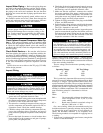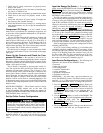
Table 7 — Recommended Compressor and
External Gear Fastener Tightening Torques
FASTENER
DIAMETER (in.)
TORQUE*
Lb.-Ft. (N
•
m)
UNC Minimum Maximum
1
⁄
4
7 (9.5) 9 (12.2)
5
⁄
16
14 (19.0) 17 (23.1)
3
⁄
8
25 (33.9) 31 (42.0)
7
⁄
16
40 (54.2) 50 (67.8)
1
⁄
2
60 (81.4) 75 (101.7)
9
⁄
16
87 (118.0) 108 (137.0)
5
⁄
8
120 (162.7) 150 (203.4)
3
⁄
4
213 (288.8) 266 (360.7)
7
⁄
8
343 (465.1) 429 (581.7)
1 515 (698.3) 643 (871.9)
1
1
⁄
8
635 (861.1) 793 (1075.3)
1
1
⁄
4
896 (1215.0) 1120 (1518.7)
1
3
⁄
8
1175 (1593.3) 1468 (1990.6)
1
1
⁄
2
1560 (2115.4) 1950 (2644.2)
1
3
⁄
4
1828 (2478.8) 2286 (3099.8)
2 2750 (3729.0) 3437 (4660.6)
2
1
⁄
4
4022 (5453.8) 5027 (6816.6)
2
1
⁄
2
5500 (7458.6) 6875 (9322.5)
2
3
⁄
4
7456 (10,110.3) 9323 (12,642.0)
*Dry fastener.
NOTE: The torque values listed are to be used for end covers, seal
cages, shaft guards, inspection covers, and housing split line bolts,
unless otherwise specified on the drawing or assembly instructions.
Carrier Comfort Network Interface — The Carrier
Comfort Network (CCN) communication bus wiring is sup-
plied and installed by the electrical contractor. It consists of
shielded, 3-conductor cable with drain wire.
The system elements are connected to the communication
bus in a daisy chain arrangement. The positive pin of each
system element communication connector must be wired to
the positive pins of the system element on either side of it;
the negative pins must be wired to the negative pins; the sig-
nal ground pins must be wired to signal ground pins.
To attach the CCN communication bus wiring, refer to
the certified drawings and wiring diagrams. The wire is in-
serted into the CCN communications plug (COMM1) on the
PSIO module. This plug also is referred to as J5.
NOTE: Conductors and drain wire must be 20 AWG (Ameri-
can Wire Gage) minimum stranded, tinned copper. Indi-
vidual conductors must be insulated with PVC, PVC/nylon,
vinyl, Teflon, or polyethylene.An aluminum/polyester 100%
foil shield and an outer jacket of PVC, PVC/nylon, chrome
vinyl, or Teflon with a minimum operating temperature range
of –20 C to 60 C is required. See table below for cables that
meet the requirements.
MANUFACTURER CABLE NO.
Alpha 2413 or 5463
American A22503
Belden 8772
Columbia 02525
When connecting the CCN communication bus to a sys-
tem element, a color code system for the entire network is
recommended to simplify installation and checkout. The fol-
lowing color code is recommended:
SIGNAL
TYPE
CCN BUS CONDUCTOR
INSULATION COLOR
PSIO MODULE
COMM 1 PLUG (J5) PIN NO.
+ RED 1
Ground WHITE 2
– BLACK 3
Check Starter
BE AWARE that certain automatic start arrangements
can engage the starter. Open the disconnect ahead of
the starter in addition to shutting off the chiller and pump.
Use the instruction and service manual supplied by the
starter manufacturer to verify that the starter has been in-
stalled correctly.
The main disconnect on the starter front panel may not
deenergize all internal circuits. Open all internal and re-
mote disconnects before servicing the starter.
Whenever a starter safety trip device activates, wait at least
30 seconds before resetting the safety. The microprocessor
maintains its output to the 1CR relay for 10 seconds after
starter safety shutdown to determine the fault mode of
failure.
MECHANICAL STARTERS
1. Check all field wiring connections for tightness, clear-
ance from moving parts, and correct connection.
2. Check the contactor(s) to be sure they move freely. Check
the mechanical interlock between contactors to ensure that
the 1S and 2M contactors cannot be closed at the same
time. Check all other electro-mechanical devices, such as
relays and timers, for free movement. If the devices do
not move freely, contact the starter manufacturer for re-
placement components.
3. Some dashpot-type magnetic overload relays must be filled
with oil at the jobsite. If the starter is equipped with de-
vices of this type, remove the fluid cups from these mag-
netic overload relays. Add dashpot oil to the cups per in-
structions supplied with the starter.The oil is usually shipped
in a small container attached to the starter frame near the
relays. Use only dashpot oil supplied with the starter. Do
not substitute.
Factory-filled dashpot overload relays need no oil at start-
up, and solid-state overload relays do not have oil.
4. Reapply starter control power (not main chiller power)to
check the electrical functions. When using a reduced-
voltage starter (such as a wye-delta starter) check the tran-
sition timer for proper setting. The factory setting is
30 seconds (±5 seconds), timed closing. The timer is ad-
justable in a range between 0 and 60 seconds, and set-
tings other than the nominal 30 seconds may be chosen
as needed (typically 20 to 30 seconds).
When the timer has been set, check that the starter (with
relay 1CR closed) goes through a complete and proper
start cycle.
SOLID-STATE STARTERS
The solid-state starter is at line voltage when AC power
is connected. Pressing the Stop button does not remove
voltage. Use caution when adjusting the potentiometers
on the equipment.
53


















